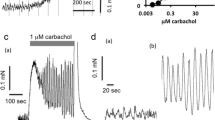Summary
The effect of (+)-tubocurarine (TC) on the release of [3H]acetylcholine from the rat phrenic nerve-hemidiaphragm preincubated with [3H]choline was investigated at different stimulation frequencies and train lengths.
At 0.5 Hz (100 pulses) TC failed to modulate the evoked acetylcholine release. A slight (30%) inhibition was observed at 1 Hz (100 pulses). Release of acetylcholine evoked at 5, 25 and 50 Hz (100 pulses) or 100 Hz (200 pulses) was markedly reduced by TC. The degree of inhibition (60%) was similar between 5 Hz and 100 Hz. A concentration of 1 μmol/l TC was a maximal effective concentration at 5 Hz whilst at all higher stimulation frequencies a 10-fold higher concentration was necessary for the maximal effect. When 300 pulses were continuously applied at 5 Hz or 50 Hz TC caused only a slight inhibition (20%). Additionally, the phrenic nerve was stimulated intermittently. Trains of 15 pulses were repeated 10 times with an interval of 3 s between each train. Under this latter stimulation condition TC failed to reduce acetylcholine release.
It is concluded that nicotinic autofacilitation of acetylcholine release from the motor nerve operates at frequencies and stimulation conditions similar to the pattern of nerve activity under in vivo conditions. At least more than 15 pulses are required before the nicotinic autofacilitation becomes apparent. It appears unlikely that the TC induced fading of end-organ responses can only be attributed to a blockade of the presynaptic nicotine receptors.
Similar content being viewed by others
References
Bennett MR, Fisher C (1977) The effect of calcium ions on the binominal parameters that control acetylcholine release during transmission of the nerve impulse at amphibian neuromuscular synapses. J Physiol 271:673–698
Betz WJ (1970) Depression of transmitter release at the neuromuscular junction of the frog. J Physiol 206:629–644
Blackman JG (1963) Stimulus frequency and neuromuscular block. Br J Pharmacol 20:5–16
Bowman WC (1980) Prejunctional and postjunctional cholinoceptors at the neuromuscular junction. Anesth Analg 59:935–943
Bowman WC (1985) The neuromuscular junction: recent developments. Eur J Anaesth 2:59–93
Dreyer F (1982) Acetylcholine receptor. Br J Anaesth 54:115–130
Fischbach GD, Robbins N (1969) Changes in contractile properties of disused soleus muscles. J Physiol 201:305–320
Gibb AJ, Marshall IG (1984) Pre- and post-junctional effects of tubocurarine and other nicotinic antagonists during repetitive stimulation in the rat. J Physiol 351:275–297
Glavinović MI (1979) Presynaptic action of curare. J Physiol 290:499–506
Grimby L, Hannerz J (1977) Firing rate and recruitment order of toe extensor motor units in different modes of voluntary contraction. J Physiol 264:865–879
Grimby L, Hannerz J, Hedman B (1979) Contraction time and voluntary discharge properties of individual short toe extensor motor units in man. J Physiol 289:191–201
Hubbard JI, Wilson DF (1973) Neuromuscular transmission in a mammalian preparation in the absence of blocking drugs and the effect of D-tubocurarine. J Physiol 228:307–325
Kilbinger H, Wessler I (1983) The variation of acetylcholine release from the myenteric neurones with stimulation frequency and train length. Role of presynaptic muscarine receptors. Naunyn-Schmiedeberg's Arch Pharmacol 324:130–133
Lee C, Katz RL (1977) Fade of neurally evoked compound electromyogram during neuromuscular block by d-tubocurarine. Anesth Analg 56:271–275
MacIntosh FC, Collier B (1976) Neurochemistry of cholinergic terminal. In: Zaimis E (ed) Neuromuscular junction, vol 42. Handb Exp Pharmacol. Springer, Berlin Heidelberg New York, pp 99–228
Magleby KL, Pallotta BS, Terrar DA (1981) The effect of (+)-tubocurarine on neuromuscular transmission during repetitive stimulation in the rat, mouse and frog. J Physiol 312:97–113
Norsted T, Jonzon A, Sedin G (1985) Continuous positive airway pressure increases vagal and phrenic nerve activity in cats. Acta Anaesth Scand 29:418–423
Silver A (1974) The biology of cholinesterases. In: Neuberger A, Tatum EL (eds) Frontiers of biology, vol 36. North-Holland, Amsterdam Oxford
St. John WM, Bartlett D (1985) Comparison of phrenic motoneuron activity in eupnea and apneusis. Respir Physiol 60:347–355
Storella RJ, Bierkamper GG (1986) Frequency-dependence of neuromuscular blockade in the presence of d-tubocurarine. Eur J Pharmacol 124:143–148
Wallenstein S, Zucker CL, Fleiss JL (1980) Some statistical methods useful in circulation research. Circ Res 47:1–9
Wessler I, Kilbinger H (1986) Release of [3H]acetylcholine from a modified rat phrenic nerve-hemidiaphragm preparation. Naunyn-Schmiedeberg's Arch Pharmacol 334:357–364
Wessler I, Halank M, Rasbach J, Kilbinger H (1986) Presynaptic nicotine receptors mediating a positive feed-back on transmitter release from the rat phrenic nerve. Naunyn-Schmiedeberg's Arch Pharmacol 334:365–372
Wessler I, Scheuer B, Kilbinger H (1987) [3H]Acetylcholine release from the phrenic nerve is increased or decreased by activation or desensitization of nicotine receptor. Eur J Pharmacol (in press)
Author information
Authors and Affiliations
Additional information
Send offprint requests to I. Wessler at the above address
Rights and permissions
About this article
Cite this article
Wessler, I., Rasbach, J., Scheuer, B. et al. Effects of (+)-tubocurarine on [3H]acetylcholine release from the rat phrenic nerve at different stimulation frequencies and train lengths. Naunyn-Schmiedeberg's Arch Pharmacol 335, 496–501 (1987). https://doi.org/10.1007/BF00169114
Received:
Accepted:
Issue Date:
DOI: https://doi.org/10.1007/BF00169114



